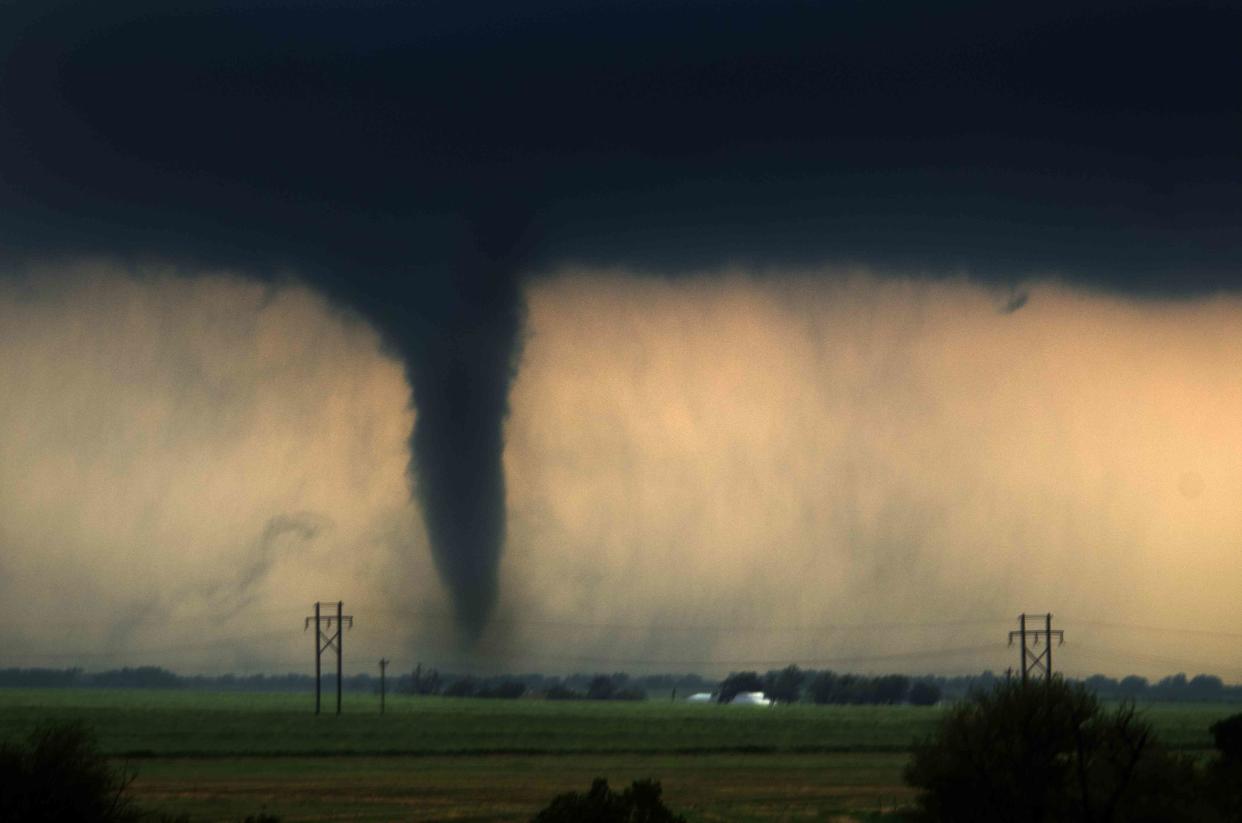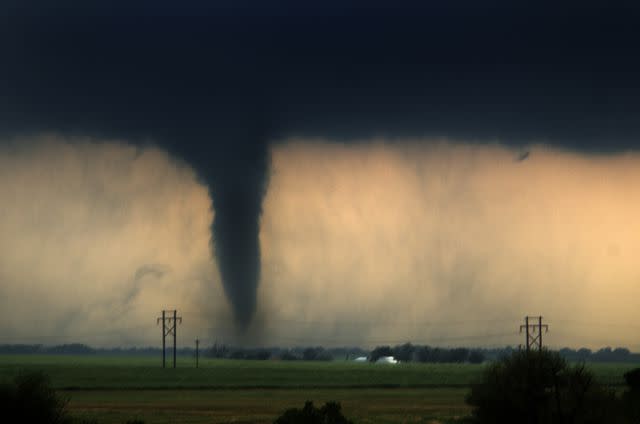Staying Safe During a Tornado: What You Need to Know

Warren Faidley/Getty Images
Fact checked by Nick Blackmer
The U.S. has seen a near-record breaking year so far in 2023 for tornado activity with 389 tornadoes from January to March.
While they can cause physical devastation to a community, tornadoes also have serious health dangers, impacting physical and mental health and wellbeing.
For those in areas where tornadoes are common or likely, preparation is key to remain safe during severe weather.

Warren Faidley/Getty Images
The United States is on track for a near record-breaking year for tornado activity in 2023.
According to a preliminary report from the National Weather Service (NWS), the U.S. saw 389 tornadoes from January to March of 2023—just under the record of 398 tornadoes during the same time period in 2017.
These weather events—essentially a funnel of thunderstorm-created swirling air that touches down and makes impact on the ground—are highly dangerous, wrenching apart buildings, sending debris flying through the air, accompanied by lightning and flash flooding, among other threats.
While they can cause physical devastation to a community, tornadoes mark serious health dangers, impacting the physical and mental health and wellbeing of those in their paths.
For those who live in a tornado-heavy region, or those who have been informed by weather reports and local authorities that a tornado is on the way, experts offer a wide range of tried-and-true recommendations for keeping yourself and those around you safe and out of harm’s way.
Finding Shelter Is Imperative During a Tornado
When asked what his main piece of advice would be for those who are under a tornado warning, John Moore, III, a public affairs specialist and meteorologist with the National Oceanic and Atmospheric Administration (NOAA)’s National Weather Service, said people must “take shelter immediately—get to your safe place.”
“The best place to shelter from a tornado is a storm shelter or basement,” Moore told Health. “If your home doesn’t have a storm shelter or basement, you should get shelter in a small interior room on the first floor of your home, such as a bathroom or closet.”
Randall Herrin, MD, emergency department medical director at the OU Health Edmond Medical Center in Edmond, Oklahoma, explained this recommendation is due to the fact that the majority of injuries that occur in a tornado “are a result of flying debris.”
This is why conventional wisdom stresses that you take shelter on the lowest floor of your home or current location, “ideally in an interior room without windows,” Dr. Herrin told Health.
“Oftentimes this is an interior bathroom or closet. It is recommended that, if able, you cover yourself with heavy blankets or even a mattress to help protect from flying debris,” he added.
Health Risks in the Aftermath of a Tornado
A tornado can have wide-ranging impacts on your surrounding environment. Damage to a person’s home, their shelter, and even a location’s air quality can have a negative domino effect on the health and safety of those who find themselves in the tornado’s path.
Moore explained that a strong or violent tornado can completely destroy one’s surrounding environment, resulting in dangers that linger long after the tornado has passed.
“Damage to infrastructure can cause gas leaks and downed power lines can lead to threats of electrocution,” Moore said. “After a tornado, if you smell gas, evacuate the area, and if you see downed power lines, do not touch them. Wait until utilities are completely turned off to start the cleanup or debris removal process.”
According to the American Lung Association, tornadoes can also affect an area’s surrounding air quality, citing the pollutants from various surrounding sources swirled up and expelled by the column of fast-moving air. A nearby pipeline could be damaged or destroyed, for instance, releasing toxic materials like oil, or asbestos, which could contaminate soil or groundwater near by.
Dr. Herrin cautioned that its important to note these dramatic environmental shifts aren’t typically the norm “beyond the acute event” of the initial tornado.
“Absent a direct hit on a water treatment facility or similar, long-term effects on the drinking water and other aspects of civil infrastructure are rare,” Dr. Herrin said. “Though tornadoes can be quite destructive to infrastructure within their direct path, widespread loss of civil services is rare and typically brief.”
Lingering Mental Health Conditions Linked to Tornadoes
A 2022 review published in the International Journal of Environmental Research and Public Health offers a snapshot of the ways in which tornado events can affect one's mental health.
The trauma that can be brought on by the physical destruction caused by this kind of extreme weather event can result in conditions such as post-traumatic stress disorder (PTSD), depression, or anxiety for “months to years after a tornado,” the authors wrote. This is true for both adults and children.
“Experiencing a tornado can understandably result in feelings of acute anxiety, especially in children,” Dr. Herrin said. “Long-term effects such as PTSD are often seen in people who have experienced a loss of property or loved ones as a result of a tornado event. This is not uncommon.”
If you are a survivor of a tornado and find yourself experiencing changes in your mental health and overall wellbeing speak with your medical provider or a trained mental health counselor or therapist to process your trauma.
How to Prepare for a Tornado
If you find yourself in an area with a tornado warning or that has a history of tornadoes, Moore and Dr. Herrin both asserted you should emergency provisions and supplies on hand.
“An emergency tornado supply kit should be stored in or near your shelter area. A supply kit should include things such as flash lights, extra batteries, water, a first-aid kit, non-perishable food items, and other things that could help you survive days without utilities,” Moore said. “Other good items to have near your shelter area are a pair of shoes, in case you have to shelter quickly and don’t have enough time to put on shoes if you’re in bed sleep, a whistle to help first responders locate you, and a helmet to help protect your head from flying debris.”
Dr. Herrin added that you should have a battery-powered radio that could be helpful in the event of a power outage in your area. He also cautioned you should maintain “a charge on your personal devices” on the day of a tornado warning so that you do have access to a mobile phone or laptop in case you lose access to power.
Moore also recommended that you have 72 hours’ worth of water on hand for each person in your home or shelter. If a major tornado disrupts water utilities for hours, days, or even weeks down the line, you will want to make sure you have clean, safe drinking water.
For those who are looking for tools to stay on top of tornado warnings and alerts, Moore suggested that you tune into NOAA Weather Radio, which provides real-time updates. Additionally, he suggested you “develop a family disaster and communication plan.”
“This plan should include where to shelter, how to shelter, emergency contact information,” Moore said, “and steps to take if you’re home is impacted.”
For more Health news, make sure to sign up for our newsletter!
Read the original article on Health.

